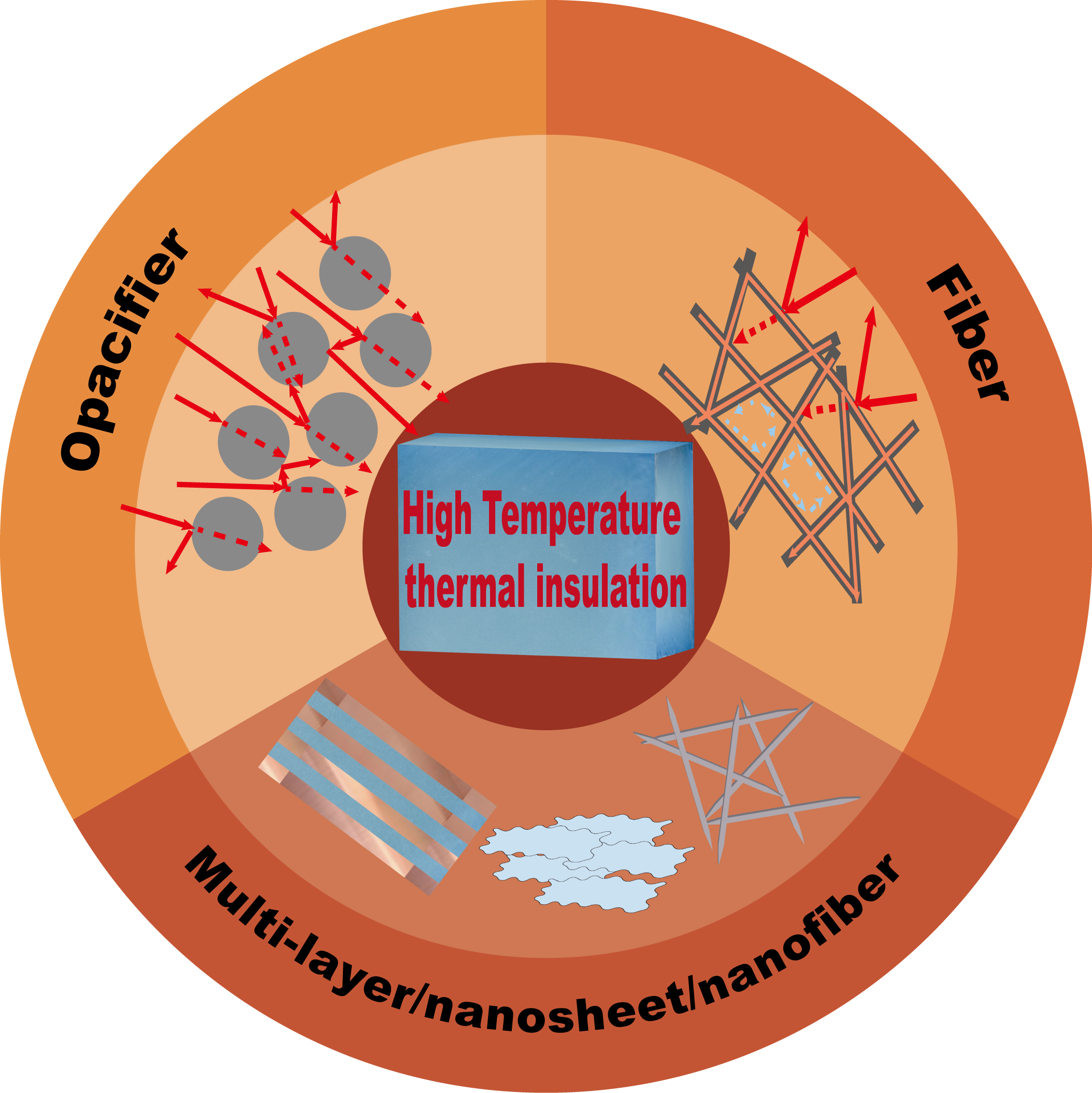 PDF(18082 KB)
PDF(18082 KB)


Research Advances on High-Temperature Infrared Modification of Oxide Aerogels
Ruiming Huang, Yonggang Jiang, Fengqi Liu, Junzong Feng, Liangjun Li, Jian Feng
Prog Chem ›› 2024, Vol. 36 ›› Issue (2) : 234-243.
 PDF(18082 KB)
PDF(18082 KB)
 PDF(18082 KB)
PDF(18082 KB)
Research Advances on High-Temperature Infrared Modification of Oxide Aerogels
Oxide aerogel is a novel nano-porous material with ultra-low thermal conductivity. In particular, it can be used in spaceflight applications and other thermal management fields. Currently, with high infrared transmittance, most of the common pure oxide aerogels, such as silica and alumina, have no advantages in high-temperature insulation because of their intrinsic property. However, electromagnetic radiation in the near-infrared region is the main mode of heat conduction at high temperatures, accordingly, a large amount of electromagnetic radiation will pass through aerogel and lead to the rapid increase of thermal conductivity. Therefore, to meet the requirement of thermal insulation at higher temperature, it is necessary to reduce the radiative heat transfer. Based on the research status, this paper reviewed the main progress of improving high temperature insulation of oxide aerogel by adding opacifier, fiber and adjusting the structure and morphology. Moreover, the future research direction has prospected.
Contents
1 Introduction
2 Application of opacifiers in infrared modification of aerogels
2.1 TiO2 opacifier
2.2 SiC opacifier
2.3 Carbon materials opacifier
2.4 Other opacifier
3 Application of fiber in infrared modification of aerogels
3.1 Glass fiber
3.2 ZrO2 fiber
3.3 Mullite fiber
3.4 Modified fiber
4 Application of structure/morphology change in infrared modification of aerogels
4.1 Multiple-layer aerogel insulation materials
4.2 Lamellar aerogels
4.3 Nanofiber aerogels
5 Conclusion and outlook

oxide aerogel / infrared modification / composite material / high temperature insulation / opacifier / fiber
| [1] |
|
| [2] |
|
| [3] |
陈龙武, 甘礼华. 化学通报, 1997,(8): 21.)
|
| [4] |
(柳凤琦, 姜勇刚, 彭飞, 冯军宗, 李良军, 冯坚. 化学进展, 2022, 34(6): 1384.)
|
| [5] |
|
| [6] |
|
| [7] |
|
| [8] |
|
| [9] |
|
| [10] |
|
| [11] |
|
| [12] |
|
| [13] |
(朱召贤, 王飞, 姚鸿俊, 董金鑫, 龙东辉. 无机材料学报, 2018, 33(9): 969.)
|
| [14] |
|
| [15] |
|
| [16] |
|
| [17] |
|
| [18] |
|
| [19] |
|
| [20] |
|
| [21] |
(雷营生, 徐红艳, 董德平, 谢荣建. 低温与超导, 2018, 46(11): 15.)
|
| [22] |
|
| [23] |
|
| [24] |
|
| [25] |
(孙登科. 长安大学硕士论文, 2012.)
|
| [26] |
|
| [27] |
|
| [28] |
|
| [29] |
|
| [30] |
|
| [31] |
|
| [32] |
(欧阳德刚, 胡铁山, 罗安智, 赵修建. 钢铁研究, 2002, 30(1): 40.)
|
| [33] |
(张虎, 马奕新, 王娴, 冀文涛, 李跃明, 陶文铨. 工程热物理学报, 2018, 39(5): 1039.)
|
| [34] |
|
| [35] |
|
| [36] |
|
| [37] |
赵越, 唐桂华, 陶文铨. 工程热物理学报, 2015, 36(3): 591.)
|
| [38] |
|
| [39] |
|
| [40] |
|
| [41] |
|
| [42] |
|
| [43] |
秦艳青, 姜勇刚, 冯坚, 冯军宗, 岳晨午. 材料导报, 2015(11): 129.
|
| [44] |
(甘信柱. 山东大学博士论文, 2018.)
|
| [45] |
|
| [46] |
|
| [47] |
|
| [48] |
|
| [49] |
|
| [50] |
|
| [51] |
(冯坚, 高庆福, 冯军宗, 姜勇刚. 国防科技大学学报, 2010, 32(1): 40.)
|
| [52] |
|
| [53] |
|
| [54] |
|
| [55] |
|
| [56] |
|
| [57] |
|
| [58] |
|
| [59] |
|
| [60] |
|
| [61] |
|
| [62] |
|
| [63] |
(王苗, 冯军宗, 姜勇刚, 张忠明, 冯坚. 材料导报, 2016(A2): 461.)
|
| [64] |
|
| [65] |
|
| [66] |
(李健, 张凡, 张丽娟, 李文静, 赵英民. 北京理工大学学报, 2019, 39(10): 1051.)
|
| [67] |
(朱振. 哈尔滨工业大学硕士论文, 2021.)
|
| [68] |
|
| [69] |
|
| [70] |
|
| [71] |
/
| 〈 |
|
〉 |